Welcome to the only banana bread recipe you’ll ever need! Whether you’re gluten-free or looking for a breakfast or sweet treat made with healthy, nourishing ingredients, look no further than this almond flour banana bread. It’s made with no oil, butter, or refined sugar. But you’ll never know because it’s perfectly moist and sweet. It’s the perfect recipe to make when you have extra bananas or overripe bananas about to go bad.
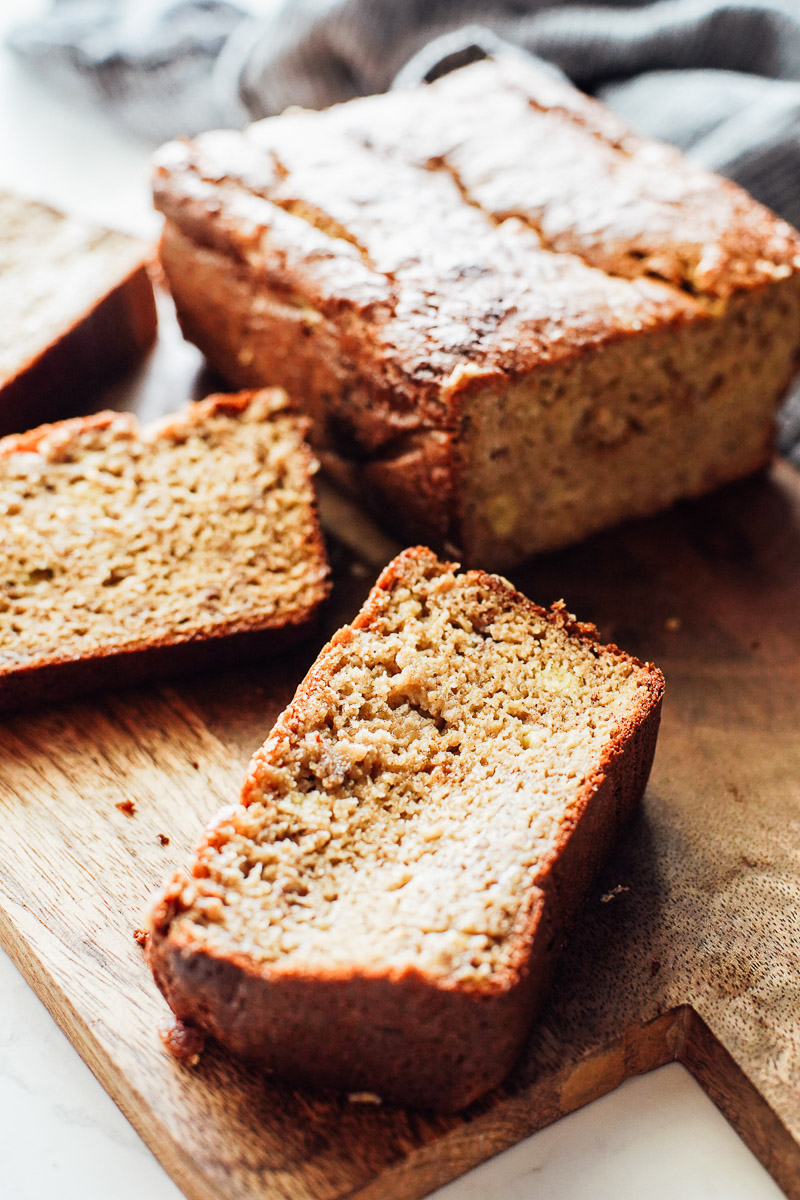
Want to Save This Recipe?
Enter your email & I’ll send it straight to your inbox. And you’ll get new recipes & tips each week.
What readers say…
“Best banana bread in the history of the world. I am seriously in love with almond flour for baking, pancakes, et. al. Everything turns out SO MOIST. This banana bread recipe is off the chart.”
Roxanne
What Makes This Recipe So Incredibly Good
In our family, we consume grains, like einkorn and spelt. It’s not uncommon for us to enjoy homemade einkorn pancakes, sourdough bread, and einkorn muffins.
I’ve also come to love gluten-free flour, particularly recipes made with almond flour. This gluten-free banana bread recipe has become a favorite with our whole family. Here’s what I love about this recipe.
- Simple, Nourishing Ingredients: We’re all about simple, real food. This recipe is the perfect example of how a few simple pantry ingredients come together to create the most delicious banana bread.
- Super Moist: Almond flour makes incredibly moist baked goods. From the softest chocolate chip cookies and bread to pancakes.
- Natural Sweetness: Typical banana bread is made with added sugar, from brown sugar to cane sugar. Instead, this healthy recipe is a quick bread you can feel good about. It’s naturally sweetened with blanched almond flour or almond meal, honey or maple syrup (or stevia for a low-carb option), and extra ripe bananas.
- Zero Gluten: This bread is 100% gluten free and the perfect treat, make-ahead breakfast, or snack for anyone with a gluten intolerance or celiac disease.
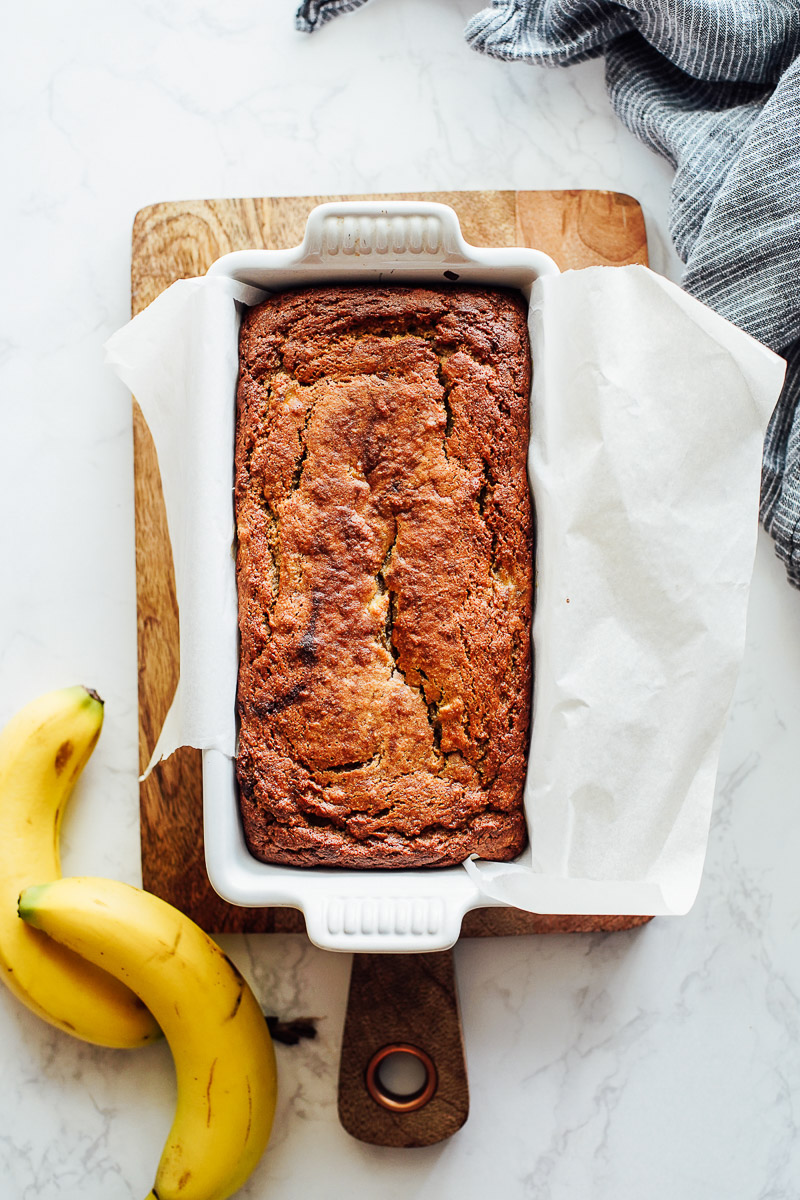
Ingredients
To make the best almond flour banana bread, you’ll need a few simple ingredients:
- 2 1/2 cups blanched almond flour
- 1/4 cup arrowroot flour starch
- 1 1/2 tsp ground cinnamon
- 1/4 tsp ground nutmeg
- 1 tsp baking soda
- 1/2 tsp salt
- 3 ripe yellow bananas
- 3 eggs
- 1/2 cup maple syrup or honey
- 1/4 cup plain whole milk yogurt or a dairy-free yogurt
- 1 tsp pure vanilla extract

What is Arrowroot Starch? Arrowroot is a white, flavorless powder. It’s similar to cornstarch (without the corn) in that it thickens food. Almond flour alone can result in a soggy, dense bread. Arrowroot starch (which is paleo-friendly, gluten-free, and vegan) improves the texture of almond flour treats. Arrowroot lasts a long time. Use it to make stir-fry sauce, almond flour chocolate chip cookies, this particular recipe, almond flour waffles, and homemade foundation powder or dry shampoo.
How to Make, Step by Step
To make this recipe, you’ll need a large mixing bowl, medium-size mixing bowl, and 9×5-inch loaf pan. Preheat the oven to 350ºF. Line the bread pan with parchment paper.
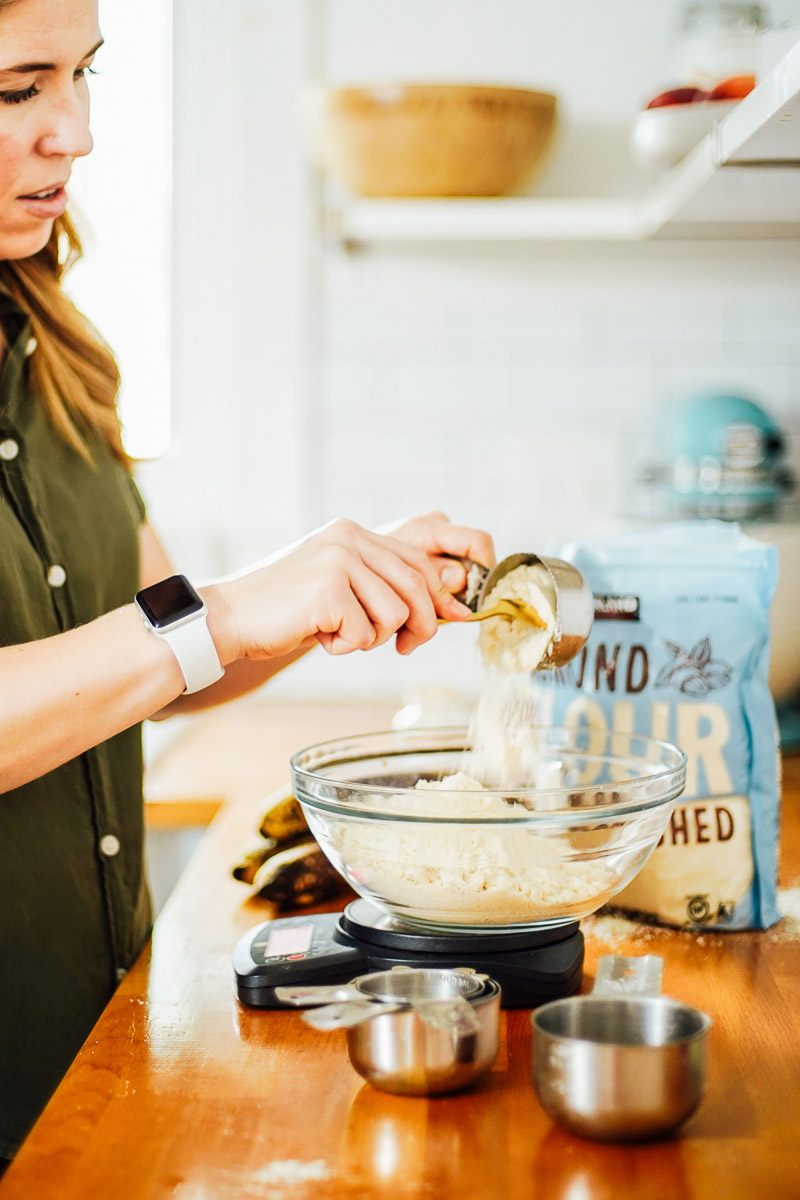
Step 1: Mix Dry Ingredients
In a large bowl, whisk together the dry ingredients: almond flour, arrowroot starch, cinnamon, nutmeg, baking soda, and salt.
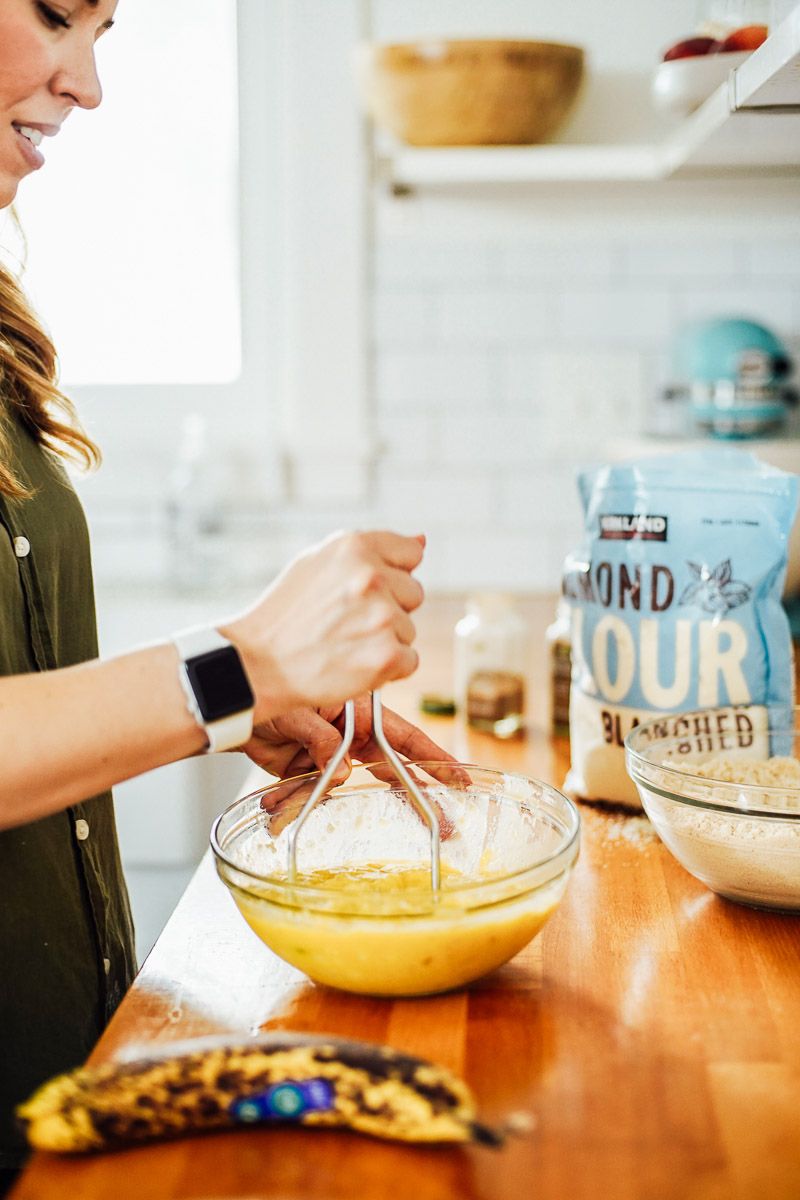
Step 2: Combine Wet Ingredients
In a medium bowl, mash the bananas. Add eggs, maple syrup or honey, yogurt, and vanilla extract. Whisk until thoroughly combined.
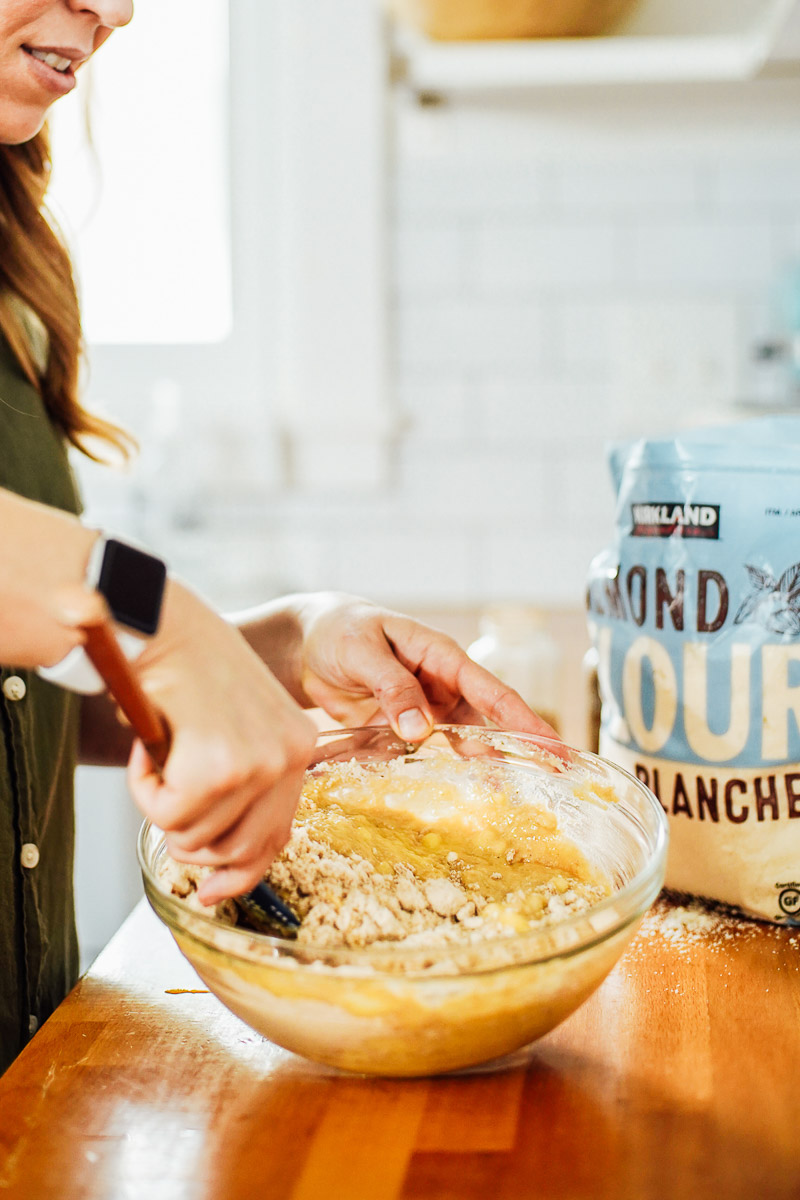
Step 3: Combine Wet and Dry Ingredients
Add the wet ingredients to the dry ingredients. Stir until combined. If you’re adding chocolate chips, walnuts, or dried fruit (see suggestions in next section), stir the ingredient into the batter now.
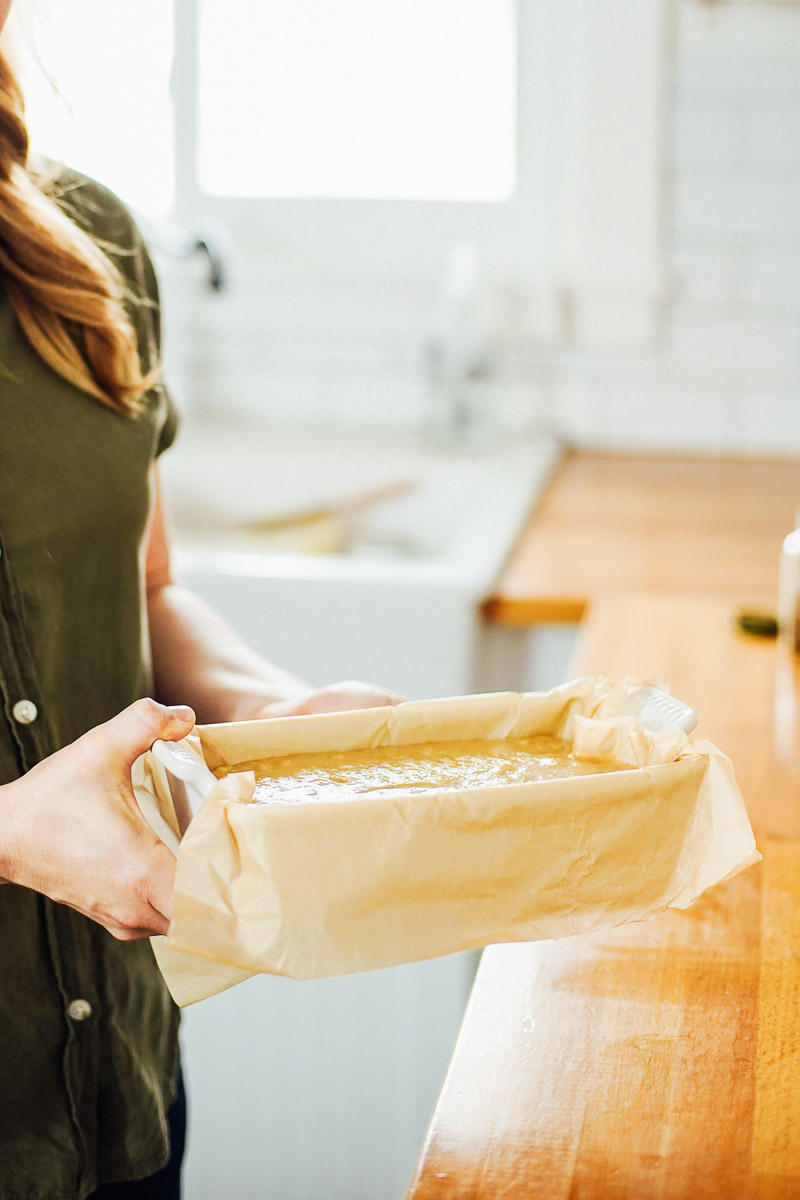
Step 4: Bake
Pour batter into the prepared loaf pan. Bake, in the center of the oven, for 60 minutes or until the center is firm. Insert a knife in the center of the bread to check for doneness. The knife should come out clean when the bread is done.
Let the bread cool for at least 20-30 minutes on the top of the stove or a wire rack. Remove the bread from the pan by lifting the parchment paper out of the pan. Almond flour sets as it cools, so it’s important to avoid cutting the bread during this time.

Add-Ins
I love plain banana bread, but sometimes it’s fun to add mix-ins. Here are a few ideas…
Dark Chocolate Chips: Add 1/2 cup of milk chocolate chips or dark chocolate chips to the batter, stir to combine. Or use cacao nibs.
Walnuts: Add 1/4-1/2 cup chopped walnuts to the batter, stir to combine.
Dried Cherries or Cranberries: Add 1/4-1/2 cup of dried fruit, like dried cherries or cranberries, to the batter and stir to combine.
Variations
Make this recipe dairy free, egg free, or sugar free. Or, instead of bread make paleo banana bread muffins.
Dairy Free: This recipe calls for yogurt. Use plain Greek yogurt, whole milk yogurt, or make it dairy-free with a plain plant-based yogurt.
Sugar Free: Instead of honey or maple syrup, some readers have used 1/2 cup applesauce or 1/2 teaspoon stevia. I haven’t tried these sweetener variations, but readers have experienced great success with these sugar-free substitutions.
Egg Free: Some readers who need an egg substitute have used flax eggs. Instead of real eggs, make a flax egg by combining flax seeds and water. How to make your own flax egg (you’ll need 3 flax eggs). This variation may result in a flat bread (a bit more dense), but still delicious.
Pumpkin Bread: If you love this healthy banana bread, try making the pumpkin variation. Use 1 cup pumpkin puree instead of mashed bananas. Follow this pumpkin bread recipe.
Make Muffins: Most quick bread recipes are easily turned into muffins by decreasing the baking time. Spoon the batter into a muffin pan with muffin liners. Bake for 22ish minutes or until firm on top. You could also make mini muffins; just use a mini muffin pan. Or, for a flourless muffin recipe, make flourless almond banana muffins.

What’s the best almond flour to use?
Almond flour is made by grinding almonds into a powder. The flour is commonly used to make keto and low carb treats. It can be used to make cake, muffins, cookies, breads, or as a binder in meatballs or meatloaf (a gluten-free alternative to breadcrumbs).
There are two different types of almond flour…
Blanched almond flour: Made by grinding up almonds with the almond skin removed. This is done by dropping the almonds in boiling water, then cooling the almonds and peeling away the skin. Once the skin is gone, the almonds are “blanched.” Blanched almond flour is a yellow/cream color, and is typically light and fluffy. It’s ideal for making pastries, cakes, and breads.
Almond meal: Made by grinding up almonds with the skin. This flour is typically brown, has a coarse texture, and results in heavier, dense baked goods.
Which is best? I’ve used both almond flour and almond meal to make this bread recipe with great success. I prefer fine almond flour for a lighter texture, but almond meal may also be used in this recipe.
Can I substitute all purpose flour for almond flour?
All purpose regular flour is not a substitute for almond flour in this banana bread recipe or other almond flour bread recipes.
Almond flour, with the absence of gluten, doesn’t perform the same as a gluten-based flour like all purpose, whole wheat flour, or einkorn flour.
If you’d like to make a regular banana bread, with a gluten flour, make this einkorn and spelt bread recipe or einkorn maple-banana muffins. Einkorn is easier to digest than wheat, so it’s my preferred gluten flour.
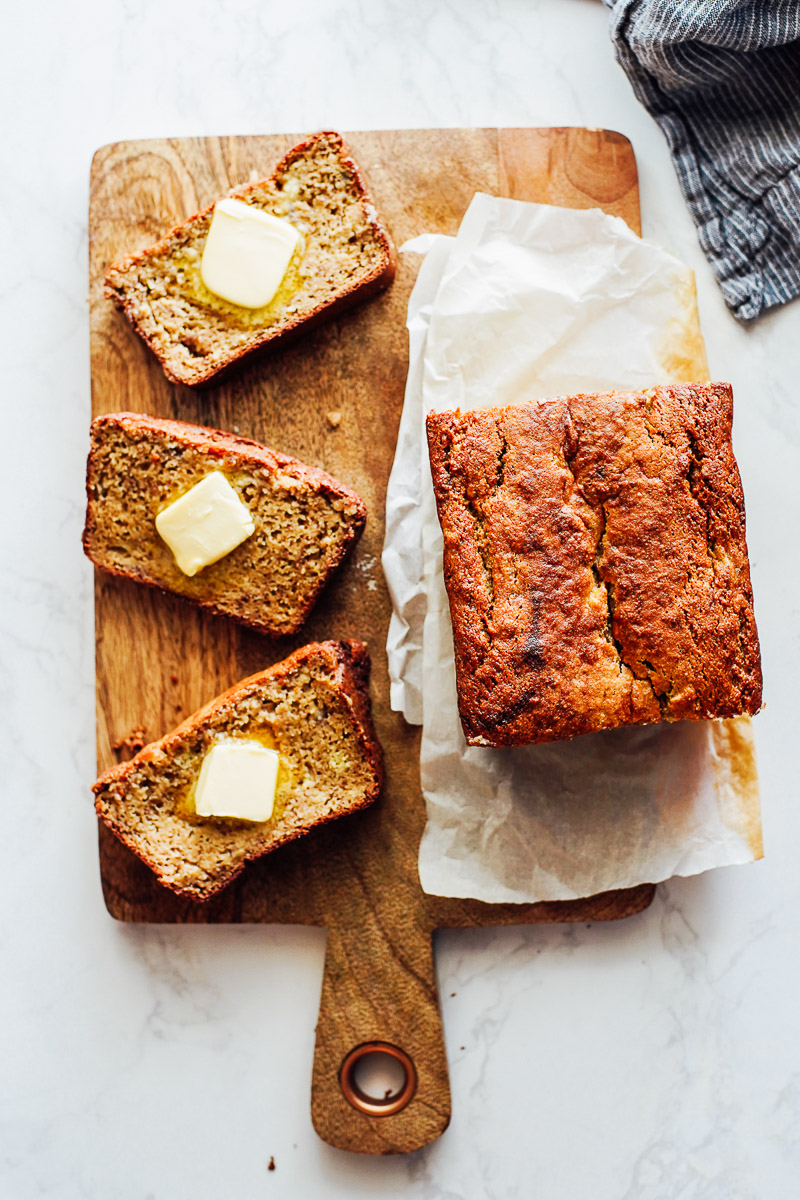
Pro Tips for Best Results
1. Weigh the flour. There is one thing that you need for fail-proof baking: a scale. Well, actually, two things: a scale and quality ingredients. My cup of flour is probably not the same as your cup of flour. Not weighing flour may result in disappointment when making cookies, cakes, or quick breads. Plus, weighing ingredients is much easier; just keep adding ingredients to the bowl until the scale tells you to stop. I’ve been using this digital scale for a few years now.
2. Use parchment paper: Line the bread pan with parchment paper so it’s easy to remove the bread and let cool. This will prevent the bread from sticking to the bread pan and falling apart, which can easily happen with almond flour before it’s fully cool. Grease the pan with a bit of oil or butter, then place the parchment paper inside the pan. The butter/oil will keep the parchment in place so it’s easy to add the bread batter to the pan.
How to Store and Freeze
Because this bread is so moist, it doesn’t dry out in the fridge. Once the bread cools, store the loaf in an airtight container or bag for up to 1 week in the fridge. Eat at room temperature, cold, or reheat a slice in the microwave or a toaster oven.
The bread is even better the next day, so make this recipe for a prep-ahead meal for breakfast, a snack, or a dinner side dish. I’ll share a few serving ideas under the printable recipe, below.
Freeze the bread, once fully cool, in a freezer bag for up to 3 months. Freeze the bread whole or sliced.
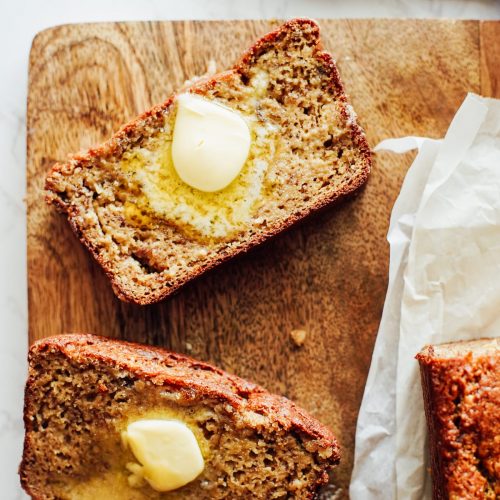
Almond Flour Banana Bread
Equipment
- bread pan 9×5-inch loaf pan
- large bowl
- medium bowl
Ingredients
- 2 1/2 cups blanched almond flour (260g)
- 1/4 cup arrowroot flour starch (34g)
- 1 1/2 tsp ground cinnamon
- 1/4 tsp ground nutmeg
- 1 tsp baking soda
- 1/2 tsp salt
- 3 ripe bananas totally 1 1/4 cups once mashed (340g)
- 3 eggs
- 1/2 cup maple syrup (134g) or honey
- 1/4 cup plain whole milk yogurt (58g) or a dairy-free yogurt
- 1 tsp pure vanilla extract
Instructions
- Preheat the oven to 350ºF.
- Line a bread pan with parchment paper, or grease with butter or coconut oil.
- In a large bowl, whisk together the dry ingredients: almond flour, arrowroot starch, cinnamon, nutmeg, baking soda, and salt.
- In a medium bowl, mash the bananas. Then whisk in the eggs, maple syrup, yogurt, and vanilla extract. Whisk until thoroughly combined.
- Add the wet ingredients to the dry ingredients, and stir until combined.
- Pour the batter into a bread pan. Bake the bread, in the center of the oven, for 60 minutes, or until the center is firm. You can insert a knife in the center of the bread to check for doneness. The knife should come out clean when the bread is done.
- Allow the bread to cool for at least 20-30 minutes. Remove the bread from the pan by lifting the parchment paper out of the pan.
- Slice and enjoy. Store any leftover bread in a bag or large airtight container. Store the bread in the fridge for up to 1 week.
Video
Notes
Nutrition
Try these simple, reader-favorite recipes that are naturally gluten-free.
Take the Guess Work OUt of meal planning
Free 64 Rotational Meals Ideas Cheat Sheet
Breakfast, lunch, dinner, and snack recipes to rotate week after week. Put healthy meals on auto-pilot.
Serving Ideas
Serve this bread as a sweet treat, breakfast, lunch, or snack (one of my favorite 31 healthy and easy snacks). Serve a slice by itself, topped with butter or almond butter, or serve a slice of bread with one of these delicious recipes for a complete meal.
For Breakfast
- Scrambled Eggs
- Spinach Feta Omelette
- Ham and Cheese Omelette
- Omelet Cups
- Healthy Yogurt Bowls
- Serve a slice with a homemade chai latte, iced chai tea latte, or pumpkin spice latte.
For Snack
- Spread two slices of bread with cream cheese to make a banana bread sandwich (also a great lunchbox meal)
- Top a slice of bread with butter or your favorite nut butter
- Serve with a cheese stick or rolled up turkey
- Enjoy a slice with a piece of fruit
For Dinner
- Serve as a side dish with a vegetable (frozen roasted vegetables are delicious) and chicken (whole roasted chicken or crispy chicken thighs)
- Serve as a side dish with a bowl of soup
- Serve on the side of a big salad, like Kale and Romain Caesar Salad

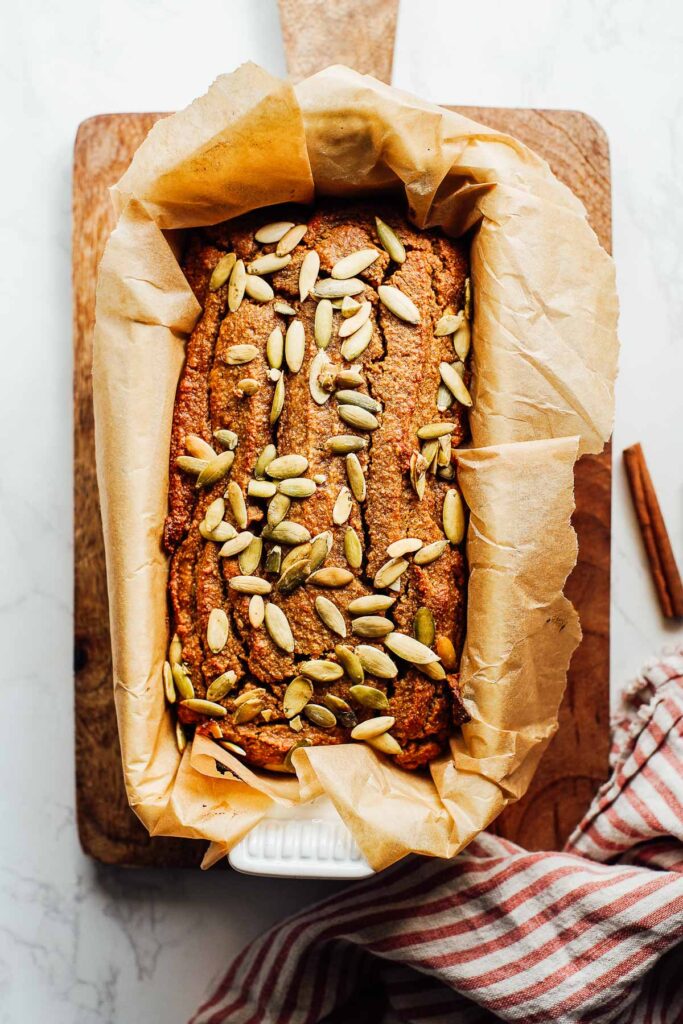
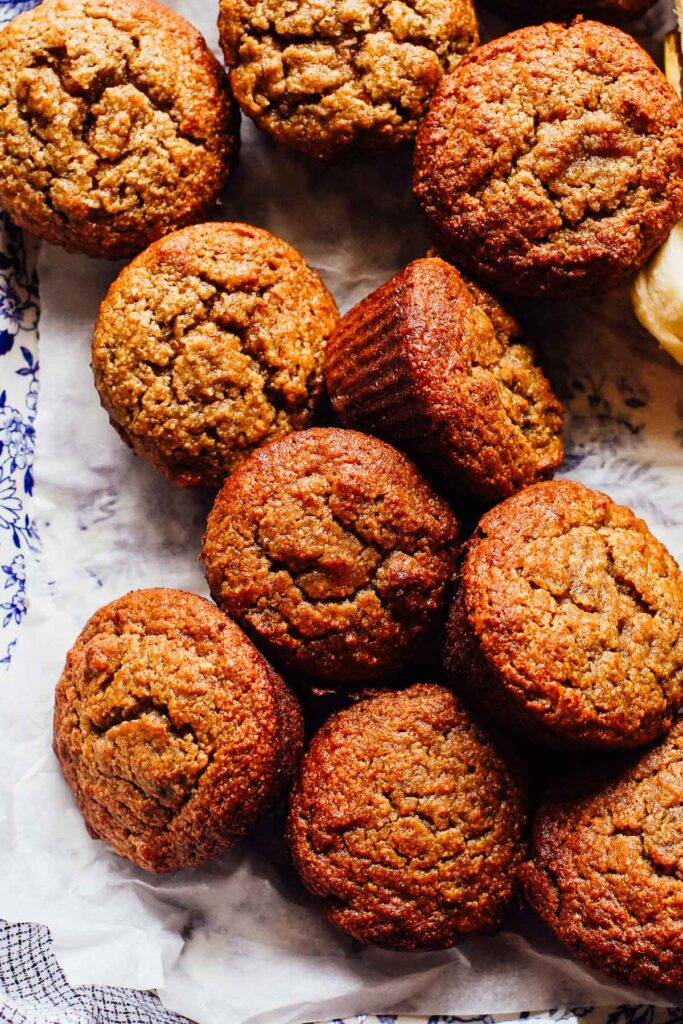
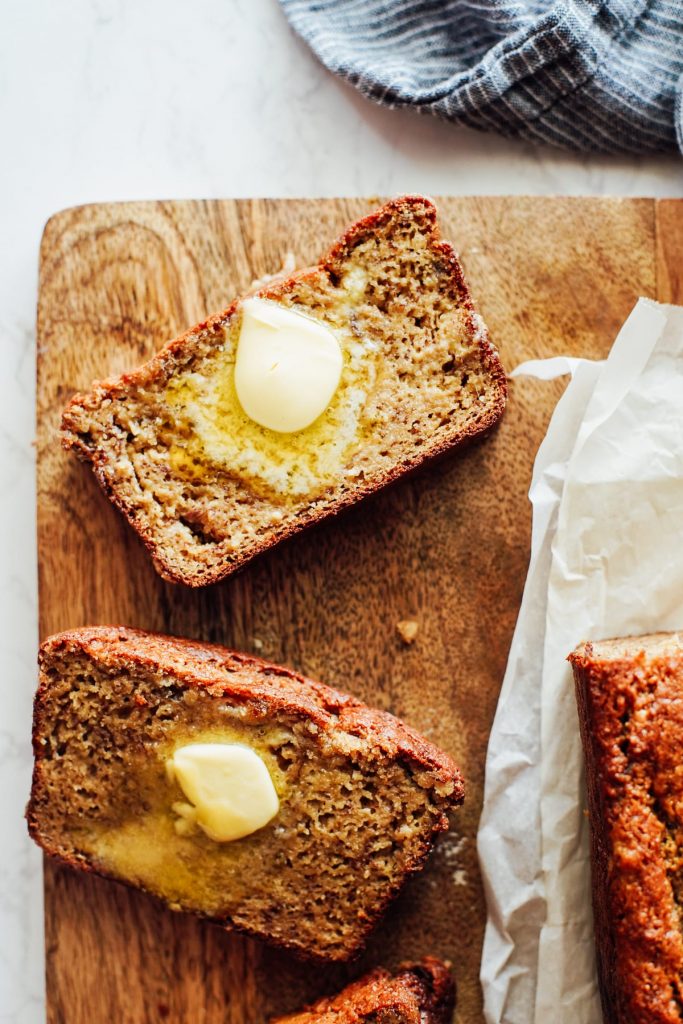
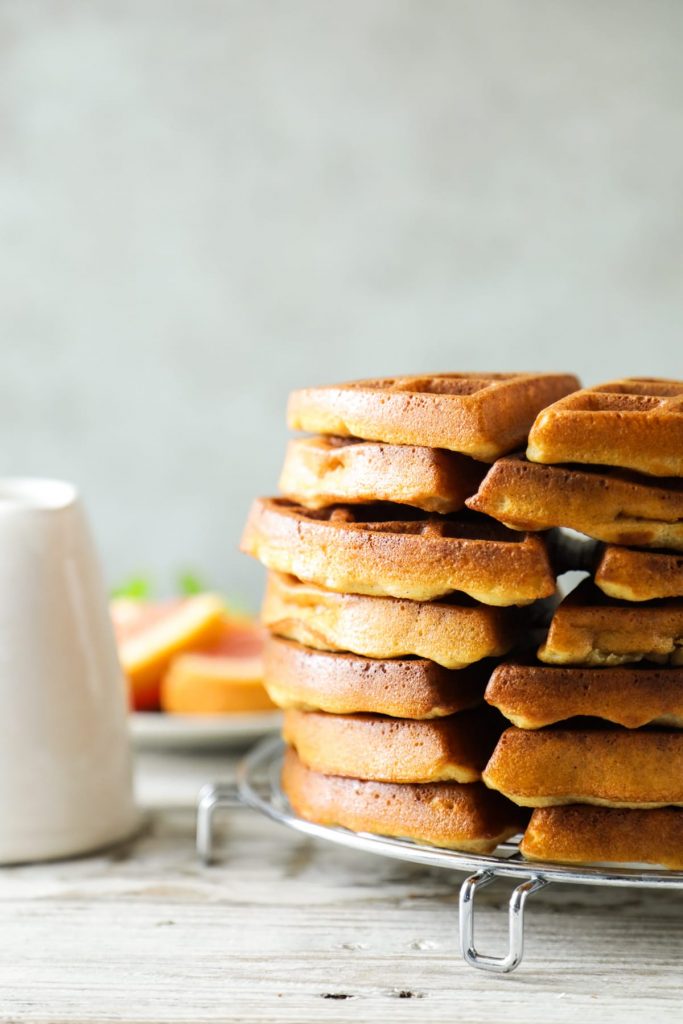
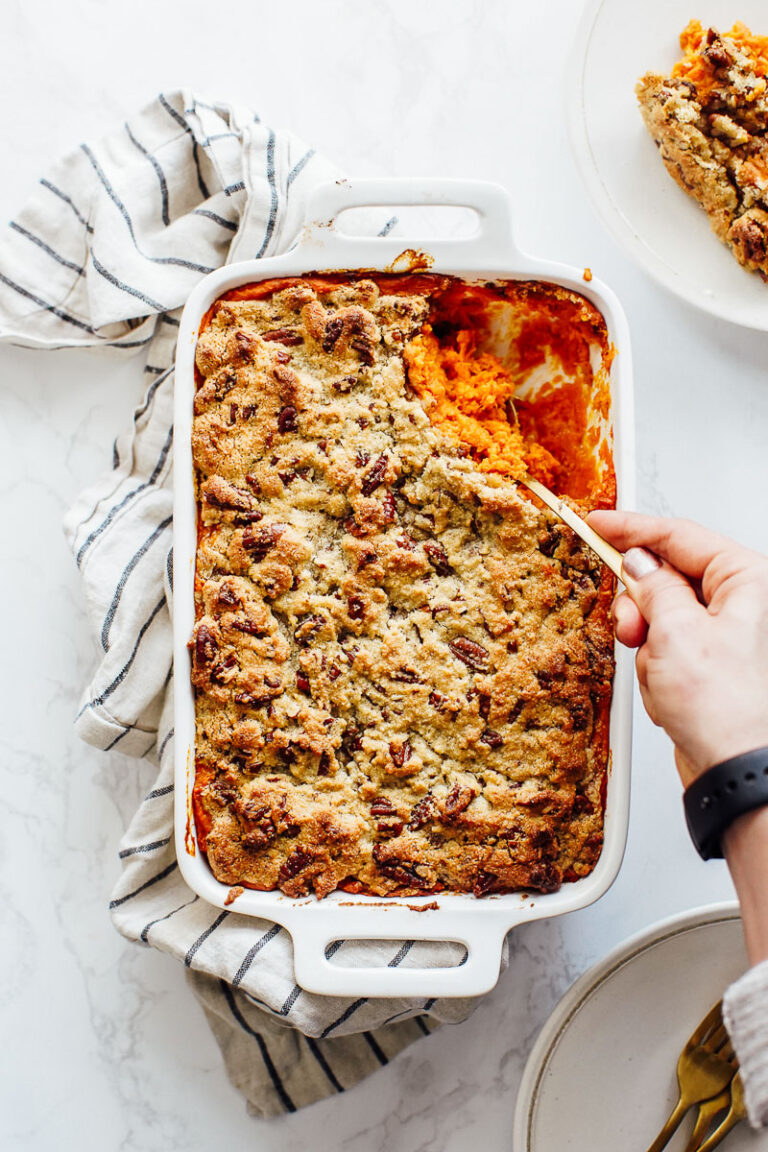
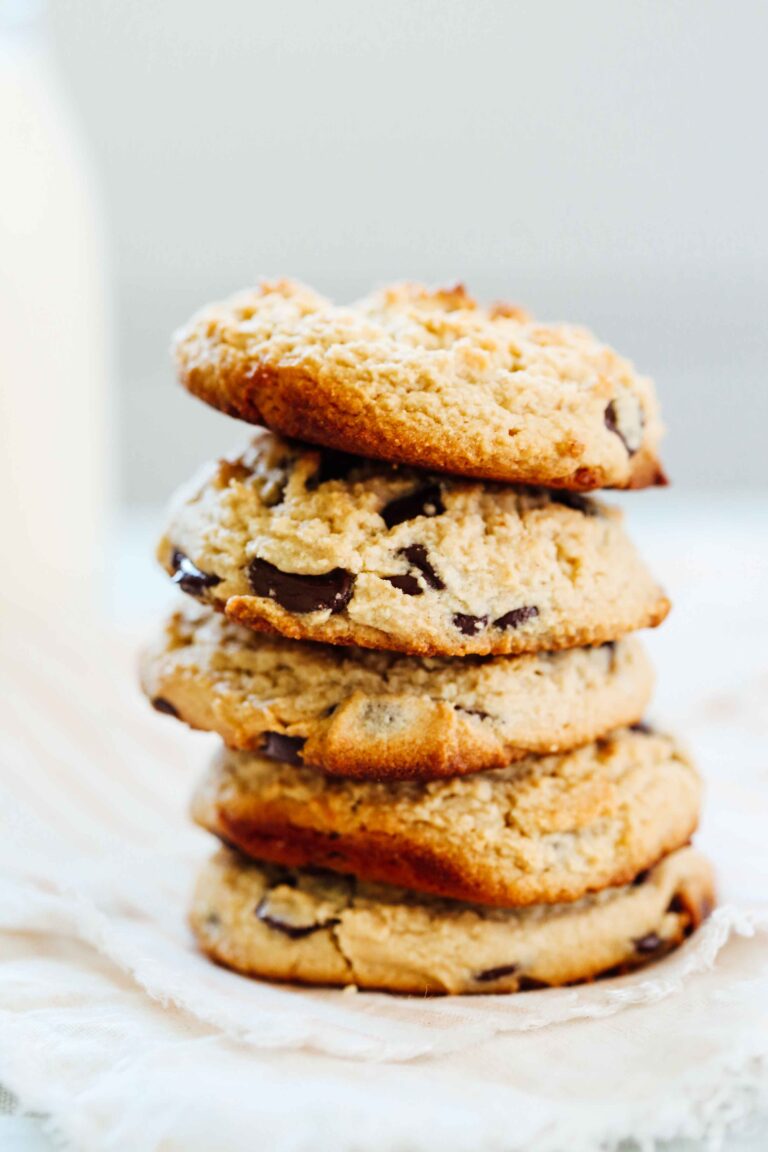
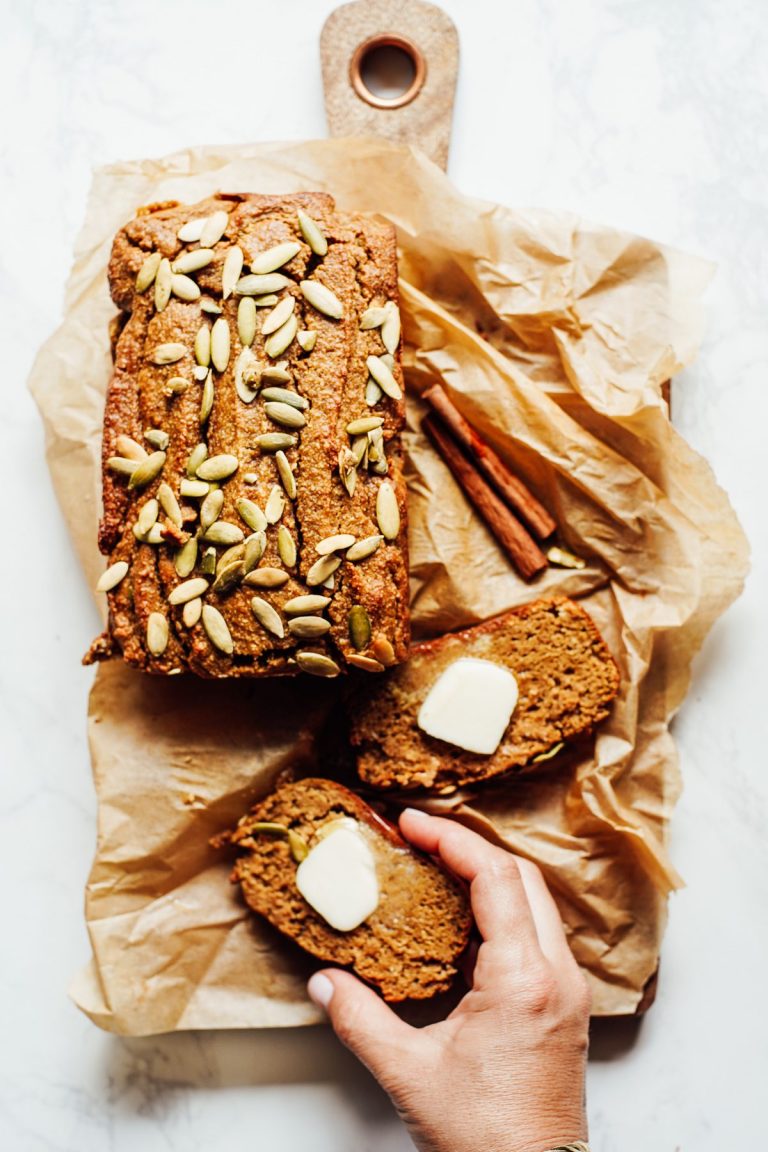
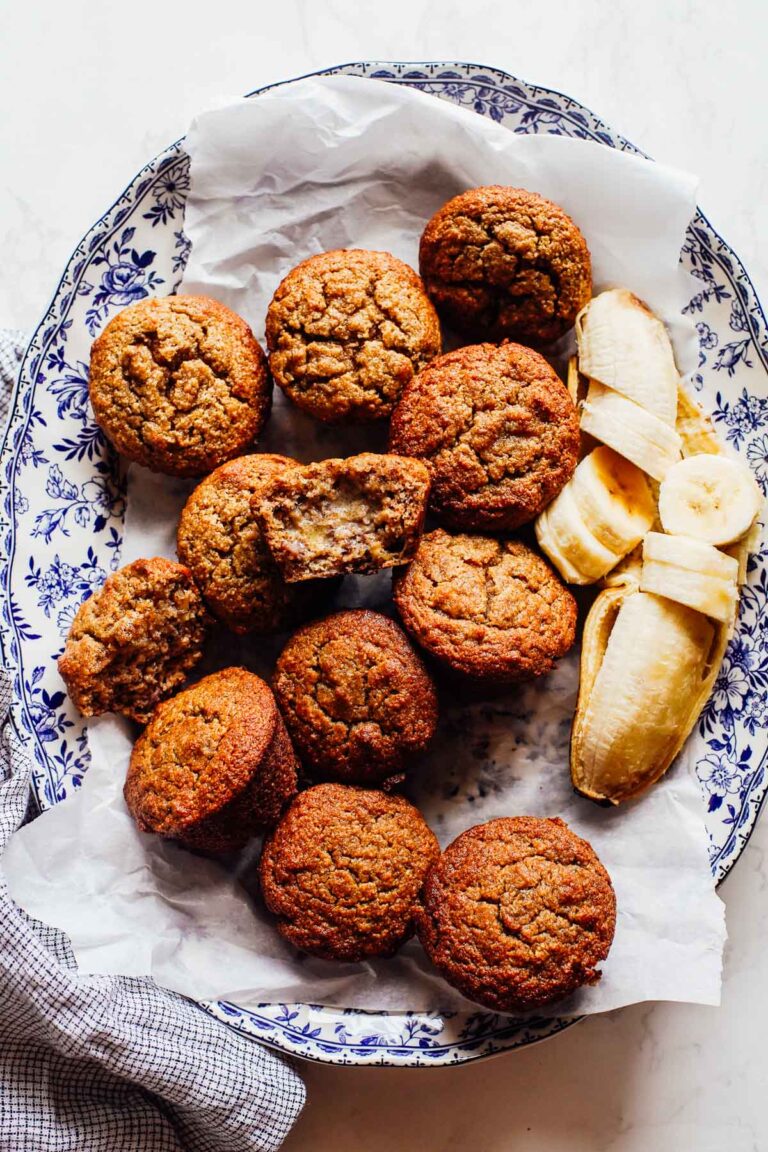
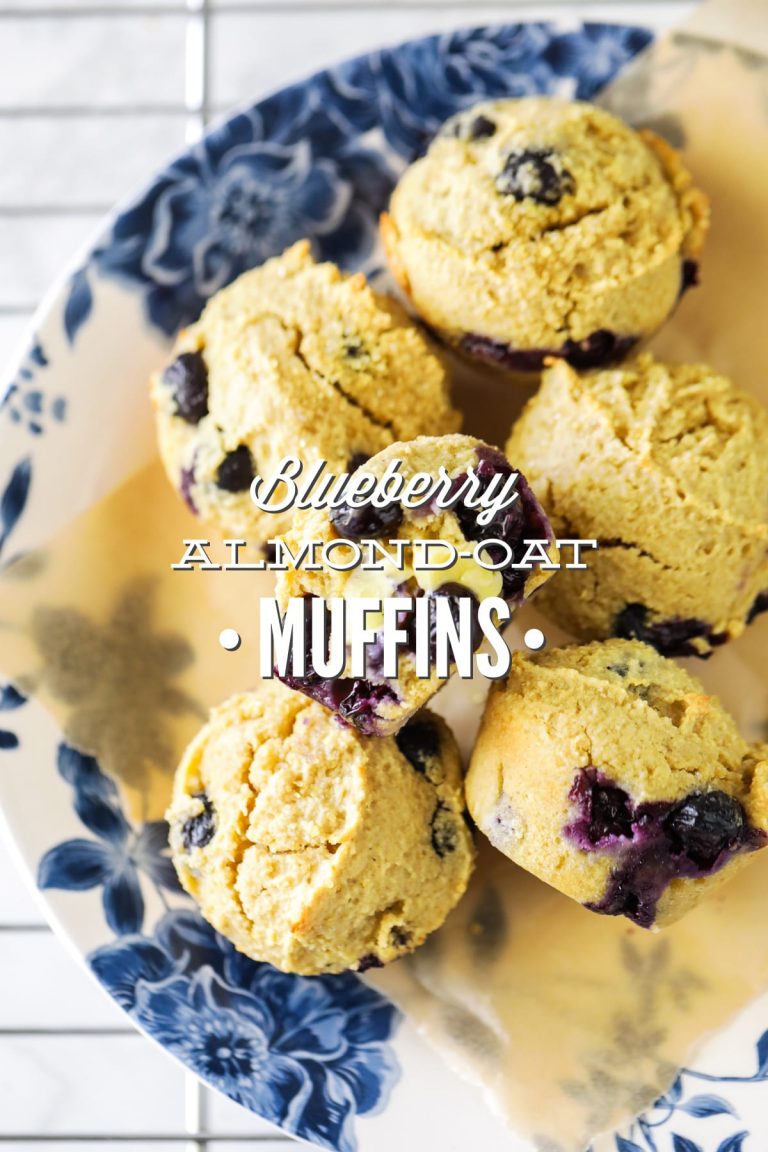
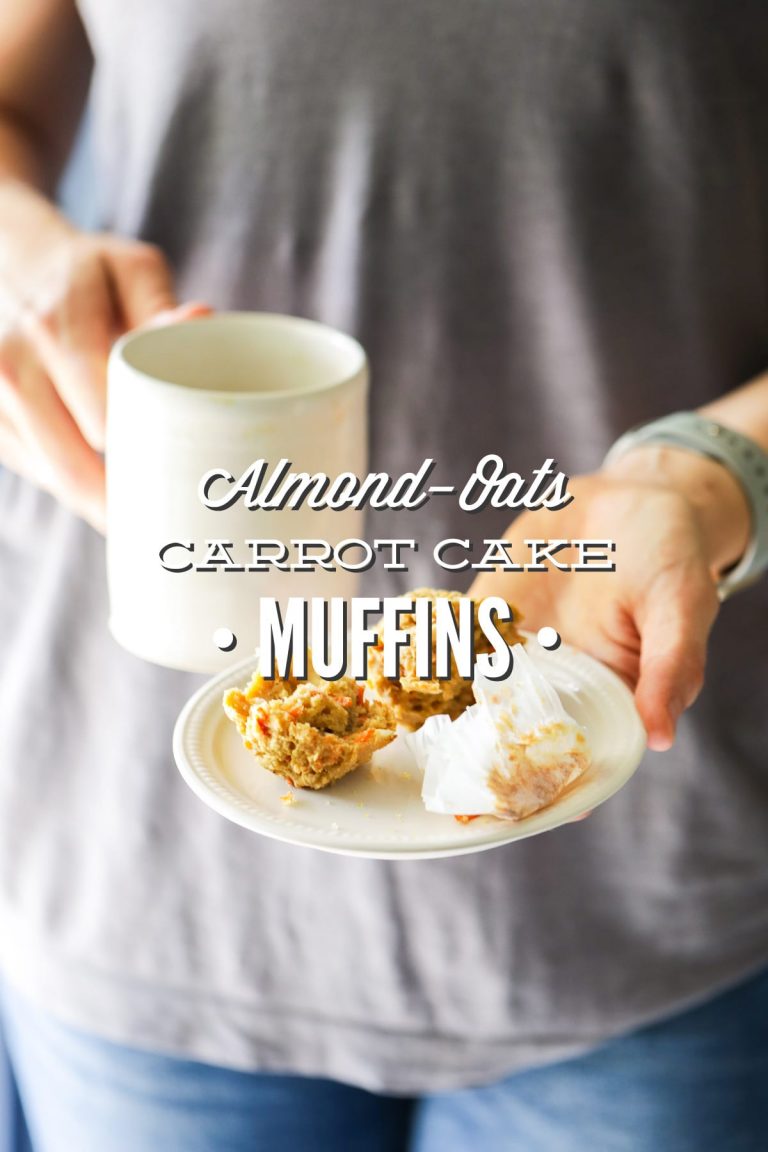
Over 50 yrs of cooking/baking I tremendously enjoy being creative with cooking. However, baking is a science, therefore measurements are important for a great end product.
I find it comical that author of this recipe recommends weighing the flour, however she states 3 bananas????? Um, large, medium or small? there is a huge difference and can make your bread either too dry or too wet. Had to pass on this recipe. eh probably wasted my time as I figure it wont be posted. Just felt badly, especially for bakers not aware of this.
So you didn’t make the bread, but want to leave a critical review? Also, there are gram measurements provided for the bananas-not “just 3 bananas” so it’s very precise. Did you miss this, or just want to be critical? Even if I stated “large bananas” that’s very subjective-a large banana to me, may be a medium banana to you or someone else. That’s why weighing is so important to baking, as you know. There are gram measurements provided for all essential ingredients-as you said baking is a science and preciseness is critical, this is why I’ve provided grams for everything and recommend using these measurements. Please let me know if you don’t see them in the recipe card and I’m happy to help.
Thank you Kristin for this recipe. It is next level delicious. I have made as noted and as muffins with coconut cream as cream replacement and baking for 23 minutes at same temp. It was perfection. I usually add powdered vanilla in addition to the liquid as who doesn’t love the bold flavor of vanilla. I’ve also made with chocolate chips and one time ground peanut flour. No matter the variation, it has turned out delicious. The fam are big fans. Thank you again 😁
Yay, so happy to hear that! Thank you for sharing, Presley! Your subs sound amazing.
My first attempt with this recipe was pretty good (I substituted the Stevia for honey/maple syrup) and it’s yummy, however it didn’t rise well because I’m at 8,500′. What adjustments should I make for next time?
Hey Lawless1, I’m not sure about baking at that elevation. Almond flour baked goods don’t rise like traditional gluten-based baked goods. I would google baking with almond flour at a high elevation and there will probably be some good tips out there. Sorry, I just don’t have any experience with this type of baking.
I have to go dairy free and am even cautious about non dairy yogurts. Would coconut milk work?
Hey Joan, It may, I haven’t tried it so can’t say 100%. I would use canned coconut milk, and scoop the thick cream off the top (use that thick cream as the yogurt replacement).
Great recipe!
Kristen I just made this banana loaf. I can cook for 20 on a whim but baking scares me. This recipe was so easy to follow – thank you. Easy ingredients and looks delicious. It’s cooling but I know it will be delicious. I added walnuts!!
Yay, so glad you enjoyed the almond flour banana bread.
Hi Kristin,
Thank you for this wonderful recipe.
I have been making the old version for 3 years now and it is always a hit.
But now I want to try it without the honey – is that possible?
Would appreciate your thoughts on this.
Thank you again
Hey Marjie, You could try without honey, but it won’t be very sweet. You’ll probably need more liquid too. Let me know if you tried it this way!
I see that this recipe has tons of great reviews, but had to add mine! I made this for the first time yesterday and was amazed at how it came out. I think this may be the closest in texture and flavor to a banana bread or tea bread made without AP flour that I’ve tried yet. I appreciate the addition of other nutritious ingredients like yogurt (I used whole goat milk yogurt in mine), honey, and 3 whole bananas. With the inclusion of 3 eggs and the healthy amount of almond flour I feel good about this as a snack or a part of a good breakfast. Our family has no health issues particularly associated with gluten, but I try to bake and cook with other products where I can to increase the nutrition profile. This is absolutely going to go into regular rotation at my house. I really appreciate your approach to ingredients and home products. Thanks for sharing!
That’s awesome, Emily! I appreciate that you came back to review the recipe. That means so much!
So good, thank you for the recipe.
This was a lovely weekend spoil to enjoy with a cup of tea 🙂
When I make my next batch I will slightly increase the amount of banana, as my first attempt tasted a bit more of cinnamon than banana for my personal taste.